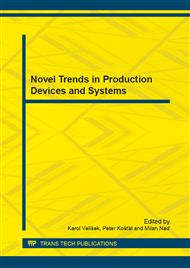[1]
L. Kukielka, K. Kukielka, A. Kulakowska, R. Patyk, L. Malag, L. Bohdal, Incremental Modelling and Numerical Solution of the Contact Problem Between Movable Elastic and Elastic/Visco-Plastic Bodies and Application in the Technological Processes (in this Journal).
DOI: 10.4028/www.scientific.net/amm.474.159
Google Scholar
[2]
L. Luca, S. Neagu-Ventzel, I. Marinescu, Effects of working parameters on surface finish in ball-burnishing of hardened steel, Precision Engineering 29 (2005).
DOI: 10.1016/j.precisioneng.2004.02.002
Google Scholar
[3]
W. Przybylski, J. Zielinski, Finishing of the aluminium alloys using sliding burnishing, in W. Przybylski (Eds. ), Present Problems in Sliding Burnishing Technology, Gdansk, 2005 (In Polish).
Google Scholar
[4]
J. Chodor, L. Kukielka, Numerical analysis of micromachining of C45 steel with single abrasive grain, GAMM 79th Annual Meeting of the International Association of Applied Mathematics and Mechanics E-Publishing (2008) Bremen.
DOI: 10.1002/pamm.200810715
Google Scholar
[5]
J. Chodor, L. Kukielka, Numerical analysis of the influence of abrasive grain geometry and cutting angle on states of strain and stress in the surface layer of object, in J.T.M. De Hosson, C.A. Brebbia, S-I Nishida (Eds. ), Contact and Surface, WITPRESS, Ashurst, Southampton, United Kingdom, 2007, pp.183-193.
DOI: 10.2495/secm070181
Google Scholar
[6]
J. Chodor, L. Kukielka, B. Storch, New method of determination of tool rake angle on the basis of crack angle of specimen in tensile test and numerical simulations, in J.T.M. De Hosson, C.A. Brebbia (Eds. ), Surface Effects and Contact Mechanics: Computational Methods and Experiments, WITPRESS, Ashurst, Southampton, United Kingdom, 2009, pp.207-216.
DOI: 10.2495/secm090191
Google Scholar
[7]
B. Kruszynski, The influence of treatment on the properties of the surface layer, Review of the Mechanical 3 (1994) 7-12 (In Polish).
Google Scholar
[8]
L. Bohdal, P. Walczak, Eco-modeling of metal sheet cutting with disc shears, Annual Set The Environment Protection 15 (2013) 863-872. (In Polish).
Google Scholar
[9]
L. Bohdal, Finite element simulation of 3D sheet metal guillotining using elastic/visco-plastic damage model, Steel Research International. Special Edition, 14th International Conference on Metal Forming 2012, pp.1419-1422.
Google Scholar
[10]
S. Legutko, S. Nosal, Forming of the technological and operation surface layer of the machine's parts, Measurement Automation and Control, Poznan, 2004 (In Polish).
Google Scholar


